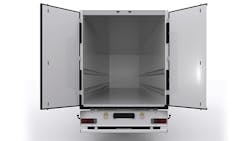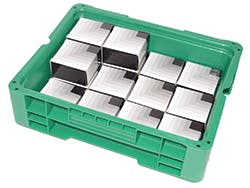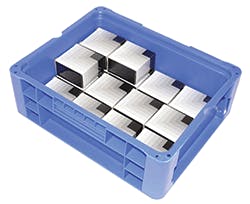Logistics Drive Reusable Container Selection
Reusable containers can cut expenses throughout the supply chain by reducing packaging, labor costs and product damage. To get the most return on your investment in reusables, however, you need to pick the right container that optimizes cube utilization and reduces freight costs.
In packaging school, I was taught to build out packaging decisions throughout the supply chain based on the primary product. However, my 27 years of experience in packaging has taught me that the reverse is true: logistics should be the first step.
Too often, supply chain managers build their logistics equation around the primary product package first and consider the mode of transport last. Too late they learn that they have added long-term freight costs because their reusable containers and pallets are not optimizing cube utilization. The dimensions of your method of transportation and your product to be packaged are fixed, but you have flexibility in your choices of primary product protection, transport container and palletization.
Let's walk through the process of selecting pallets and containers using the traditional approach and then the new “logistical reversed order." Let's assume that our product is a tape measure and we are shipping them from a manufacturing plant to a distribution center (DC). Many engineers approach the problem in this order:
- Primary – end-user container or dunnage
- Secondary – reusable container
- Tertiary – pallet / skid / palletized load.
In our example, the box that houses each tape measure is the primary package/dunnage. The secondary packaging is the reusable container that houses multiple units for shipment to the DC. The third, or tertiary, level is the pallet or skid that will support multiple containers.
After selecting and purchasing the containers and pallets, the material handling/logistics team uses a cube analysis process to determine how many products can be loaded onto a pallet for shipment. At this point, they realize that the dimensions of the transport containers they purchased do not maximize the cube utilization in the truck, rail, or sea container that is delivering the products. Now, it is too late and too costly to buy a different reusable container. As a result, the company will pay extra and unnecessary freight costs with every shipment. You pay for reusable packaging only once, but you pay freight costs forever.
At the time of writing this article, fuel prices are down considerably. However, when diesel prices near $4 a gallon again, cube and distribution will once more become top concerns. And even at lower prices, why pay more than you need to?
Reversing the Order for Logistics
Now let's step through the process in reverse order and add a critical fourth level: method of shipment. The correct decision order is:
- Primary – truck/train/ship
- Secondary – pallet/skid/palletized load
- Tertiary – reusable container
- Quaternary – dunnage/primary packaging.
In this scenario, logistics is driving the packaging selection. As before, we are shipping product (the tape measure) from a manufacturing plant to a customer distribution center. It's a regional DC and a non-perishable item so we are shipping via a non-refrigerated tractor-trailer. The most common size trailer today is 53' high cube (110"). Cube is maximized with common pallet sizes: 48" x 45", 48" x 40", and 32" x 30". Our choice of transportation—the truck—dictates the choices in pallet size. If we were shipping by a sea container, we would need to choose from standard pallet sizes of 1200 x 1000 mm, 1190 x 1140 mm, and 1200 x 800 mm. If shipping by rail, our palletization options are further complicated, but less common.
In addition to cube utilization, other top-line factors that drive pallet selection include:
- Standards for your particular industry: For example, 48" x 45" is the standard in automotive and many industrial manufacturing chains within North America.
- Intra-logistics: If you use a forklift or automation, you might need robust pallets with fork straps, runners and/or pallet reinforcement. Open-leg or nine-leg pallet styles are typically not suitable for automated warehouses.
- Product regulations: If you have a food item that will touch the pallet or if the pallet will be placed inside a food processing area, then your pallet needs to meet food safety guidelines.
In our example, we chose the 48" x 45" pallet due to our use of the 53' trailers for shipping. Now that we've identified our mode of transit and selected our pallet, we can move on to decisions about tertiary packaging: the reusable container.
Selecting the Optimum Container
Logistics continues to influence our decisions in this third step. If the transportation loop is 500 miles or less, then you can consider a non-collapsible, straight-walled container. However, if your loop is longer, you might want a container that is nestable or collapsible in order to reduce return freight costs. Here are other secondary—but key—considerations for the selection of your reusable containers:
- Electrical components need a container with electrostatic discharge (ESD) protection.
- Food products must be in containers that meet food safety regulations and can be integrated into sanitation processes, such as infrared and washing.
- Consider whether containers will be handled manually or with automation. If employees are lifting the containers, you need to stay within a maximum hand-held weight. Containers used in automated processes can be larger to hold more product, but must also be more robust.
The selection of your reusable container will require much more thought and input than the first two levels because the choices are much greater. Reusable containers come in many forms: bulk, handheld, collapsible, straight wall and stackable. In addition, many have industry-specific features like pocket handles for improved ergonomics, molded-in label holders and cross-stacking bottoms for mixed pallet loads.
By picking your reusable container based on your mode of transportation, you increase the likelihood that your selection is the optimum one for cube utilization and reduced freight costs. It is also more likely that the container is available off-the-shelf and you won't have to incur the expense of building a custom container.
In our example of the tape measure, we weighed these elements when picking a container:
- It needs to maximize the 48" x 45" pallet used as a standard within our loop.
- It will be lifted manually and does not need to accommodate more than 35 pounds.
- It can be straight walled because our closed shipping loop is less than 500 miles and we are not concerned with reducing return freight costs.
We enter these elements along with the dimension of our end-use product (the box housing the tape measure) into the industry container cube calculator and determine that we have two possible off-the-shelf options: 12" x 15" x 4.0" (Figure 1) and 12" x 15" x 5.0" (Figure 2) containers. Now we are ready to test them. Each container holds the same number—24 tapes measures—and the difference in weight is only 2 ounces.
However, with the 12" x 15" x 4.0" container, we see that the product is very close to the top. The product might be damaged when a second container is stacked on top. Our second option—the 12" x 15" x 5.0" —has an extra 1.0" of space at the top which will prevent any contact. This becomes our best option for quality and cube.
Dunnage/part protection can also be a complex decision-making process. For the sake of brevity, I used an example where the primary package (box housing the tape measure) became the dunnage. Additionally, we can add a lid to our reusable container for added protection from debris.
By working in reverse order, we selected a reusable container that maximizes cube utilization, minimizes freight costs, reduces product damage and is available without customization. This holistic approach to packaging selection ensures that a decision made in one area does not drive up costs in another.
David R. McCulloch is vice president and managing director, Packaging Systems Division Plastics Group, Schaefer Systems International Inc. (www.ssi-schaefer.us). He is also a member of the board of directors with the Reusable Packaging Association (www.reusables.org).
This article is based on a presentation given at the Reusable Packaging Association Reusables Learning Center at Pack Expo 2014.


